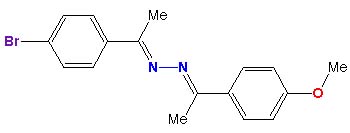Molecule of the Month - December 1997
Realization of a Near-Perfectly Dipole-AlignedCrystalline Molecular Organic Ferroelectric Material:
4-Bromo-4'-Methoxyacetophenone Azine.
A non-Chime version of this page is available.
Ferroelectric materials have large macroscopic electrical dipole polarizations. Such materials show very special anisotropic properties and they are, for example, central to the design of nonlinear optical materials.

Figure 1. Schematic diagrams of dipole alignments in the crystal.
The symbol µ (pronounce "mu") denotes the electrical dipole moment.
Organic ferroelectrical materials are hard to make. Think about it. What happens when molecules with electrical dipole moments crystallize? Well, of course, the molecules want to arrange themselves in such a fashion that the dipoles all are aligned in a head-to-tail fashion and a chain or "string" of dipoles results which are all more or less parallel aligned. How will the strings arrange themselves in the crystal? Simple ideas of electrostatics show that neighboring dipoles are electrostiaclly best when they are anti-parallel. Hence, the crystals of dipolar molecules most usually are of the type shown on the left in Figure 1: Neighboring strings are antiparallel and the result is a complete cancellation of the electrical dipole moments in the crystal. In some cases it has been possible to realize crystals that basically show the same motif but all the molecules are "kicked" a bit in the same direction (center in Figure 1) so as to render the dipole cancellation incomplete. This can be achieved for example by incorporation of chiral groups into the molecule. Crystals in which dipolar molecules all are arranged in the same direction, schematically shown to the right in Figure 1, had been thought to be impossible to realize.

Figure 2. 4-Bromo-4'-Methoxyacetophenone Azine.
With the crystals of the molecule 4-bromo-4'-methoxyacetophenone azine, shown in Figure 2, we have now realized for the first time a near-perfectly dipole-aligned crystalline organic ferroelectric material. The crystal packing of the azine is illustrated in Figures 3 and 4. The crystal contains pairs of perfectly dipole-parallel aligned azines which are held together by arene-arene T-shape contacts. Such a pair is shown in Figure 3. The azine pairs are arranged in a bilayer fashion in the crystal, ABABAB. Each layer contains perfectly dipole-parallel aligned azines and the dipole moments of the layers reinforce each other. The azines contained within the two layers are nearly colinear and the overall crystal dipole moment is about seventy percent of the theoretically maximal crystal polarization. This degree of alignment is unprecedented.
|
Use [shift]-mouse button
to resize the molecule. Use [option]-mouse button to shift the molecule. Click and hold the button while moving over the molecule to rotate manually. Click and hold the button for other menu options, such as to start or stop the rotation. | Rotate: 45° about [X |
Figure 4. Crystal packing of 4-bromo-4'-methoxyacetophenone azine.
|
Use [shift]-mouse button
to resize the molecule. Use [option]-mouse button to shift the molecule. Click and hold the button while moving over the molecule to rotate manually. Click and hold the button for other menu options, such as to start or stop the rotation. |
Rotate: 45° about [X Axes: [on Bounding box: [on Background: [black |